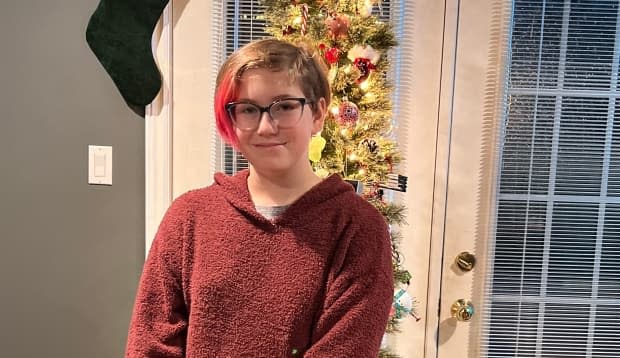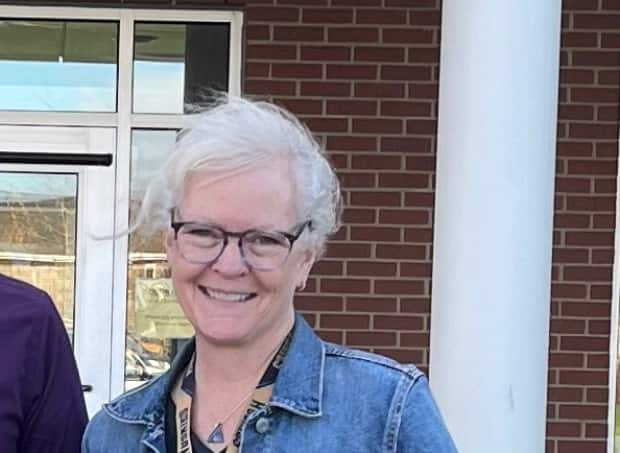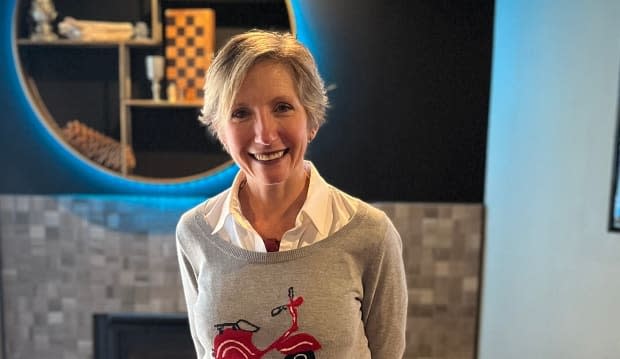An inside look at Moncton school's French learning pilot

It's mid-morning at Maplehurst Middle School. The hallways are jammed as kids move from class to class.
Above the chatter, French music blasts from speakers along the corridors. Some of the signs are in both languages.
This is Maplehurst Middle School, a new school in a fast-growing part of Moncton, and a possible glimpse of the future of French-second-language education in New Brunswick.
Maplehurst is one of 24 "language learning opportunities" projects — anglophone schools piloting new approaches to French education around the province this year as the Higgs government prepares to replace French immersion next fall.

"Our whole vision is more French, not less," principal Elizabeth Nowlan says of an approach that puts three categories of students into the same classrooms: those who entered immersion early, those who entered it late, and those who weren't enrolled in it at all.
Many students and parents sing the praises of the approach, which includes a mix of English and French learning across several subjects that would normally be taught entirely in French in the conventional immersion program.
'My vocabulary is decreasing'
For students not in immersion before, that means more French, consistent with the government's goal of giving all children a chance to achieve a conversational ability in the language.
But for students who had been in immersion, it's less classroom French than before.
Grade 7 student Natasha Robichaud says there was "way more" French in Grade 6, but now English makes up a larger part of her classroom time.

"They're giving an opportunity to students who never learn French, but to the people who already learned French, it's not giving them an opportunity. It's just kind of taking their opportunities away. By doing this, it's shutting a lot of doors for our future."
Natasha says she already feels her ability in the language getting rustier.
"I feel like I can't say I'm bilingual because now my vocabulary is decreasing."
Those differing views at Maplehurst reflect the wider dilemma around the Progressive Conservative government's plan to replace immersion: whether more French for all students must come at the expense of immersion-level learning for others.
Professor says approach not supported by research
French-second language expert Léo-James Lévesque, an education professor at St. Thomas University and a former French-education supervisor for a Fredericton-area school district, says the Maplehurst approach isn't supported by research.
"I think it's well-intentioned. I really do. But I think it's reinventing the wheel without the benefit of research, so you're repeating past mistakes."
Immersion works because it provides both intensity and exposure to French, Lévesque says. Students rise to the challenge of grasping a new language they need to learn a range of subjects.
Throwing more English into the mix to help student comprehension in the moment — as Maplehurst does, mainly for students who weren't in immersion — will mean less of an incentive to master the language over time, he says.
Danielle Elliott, a Department of Education spokesperson, said there may be less French in the classroom, but the language learning projects aim to increase exposure to conversational French outside class.
Officially, provincial policy requires immersion students in middle school to get 70 per cent of their teaching time in French.
Nowlan was vague on whether immersion students at Maplehurst are hitting that number in the pilot.
Exceptions made to 70% requirement
"Their French opportunities would be higher one day and maybe not as high on another," Nowlan says. "So it's hard to nail it down to an exact percentage, but certainly if they're taking advantage of all the opportunities, they're certainly in that range."
"All the opportunities" means French outside the classroom, which Natasha says isn't realistic for kids used to speaking English socially.
"I doubt anyone really is going to do that," she says. "They just want to talk with their friends. They're not going to be talking in French."
In an emailed statement, Elliott said schools "were granted permission to make adjustments or adaptations" to that 70 per cent requirement.

In return, school staff must meet with department officials "to ensure accountability for language acquisition."
The Maplehurst model is just one of 24 around the province, and Elliott said that "rolling out any one project provincewide is not anticipated."
But Chris Collins, the executive director of the pro-immersion Canadian Parents for French in New Brunswick, believes the program is a sign of things to come.
"We are sensing that there is not a lot of variation in the models," he says.
So even if the Maplehurst system itself isn't adopted provincewide next fall, Collins expects whatever is put in place will bear a close resemblance.
Less pressure on students, says parent
Some parents are optimistic the Maplehurst model will be a success.
Jocelyn Keech, who chairs the parent school support committee at Maplehurst, believes immersion was working but accepts the government's logic that it wasn't working well enough because it wasn't reaching most students.
One benefit of the pilot is immersion students are under less pressure, she says.
"They used to feel like they had to almost be perfect in the way that they spoke French and everything had to be just so. … I think now, having all different levels of kids, they're all trying, and they're all coming out of their shell and speaking French more."

Student Molly Teed says that's been her experience.
"I feel like I'm more motivated, like I understand everything that's being taught, and I'm not struggling to try to balance, like, new things every day," she says.
The province has promised that current immersion students will be "grandfathered" in the program and able to stick with it until they graduate.
For Maplehurst students, that means returning to it when they reach high school.
Natasha Robichaud worries that by then, she'll have fallen behind students from other schools that didn't pilot a new approach.
Her mother Christina Robichaud says the Maplehurst model focuses so much on students who haven't been in immersion that "those who were fluent are now dropping down."
Lévesque says based on his experience and research, that's a real concern, and many Maplehurst students may opt to abandon immersion.
"They will feel they no longer have a level of French enough to continue in the program. … Students will not have the motivation nor feel they have the ability to continue at the high school level."
Nowlan is more optimistic. While she doesn't know precisely how high schools will fold Maplehurst children back into the existing curriculum, "I certainly feel our children will be well prepared to be able to converse in French and carry on in the immersion program."
And Elliott says based on feedback from all the pilot schools, the department believes students "will be more likely to want to take additional French-language courses in high school and will not encounter any barriers to participation."

Even so, Maplehurst is tweaking its model.
The school told parents in October it would use extra funding to create "flexible grouping opportunities" to meet all students "where they are in their language acquisition journey."
That means students at different French levels will break into separate groups twice a week for teaching tailored to their abilities.
That, however, would appear to contradict one of the Higgs government's stated goals to eliminate streaming. Elliott did not directly respond to a question about that point.
Lévesque also questions whether the new "flexible grouping approach" will be feasible province-wide.
The department is spending $2.4 million this year to support the pilot projects, but that kind of money may not be affordable once every school in the province adopts a new model.
Maplehurst has another advantage: "the vast majority" of its teachers are bilingual, Nowlan says, giving them the ability to move between French and English fluidly as needed.
Not all schools around the province would have that ability, however.
"We are limited in the number of bilingual teachers we have" province-wide, Lévesque says. "It would certainly be difficult to replicate in other settings. … It's just not realistic you can duplicate this program."
Christina Robichaud says the bottom line is that the province is experimenting with a French program in which the language is often encouraged but not required.
"The teachers add as much French as they can, but that's it," she says.
"There isn't a strict curriculum. So based on the teacher, based on the classroom dynamic, that really is what's dictating their experience. But that is indeed not French immersion."

 Yahoo Movies
Yahoo Movies 
